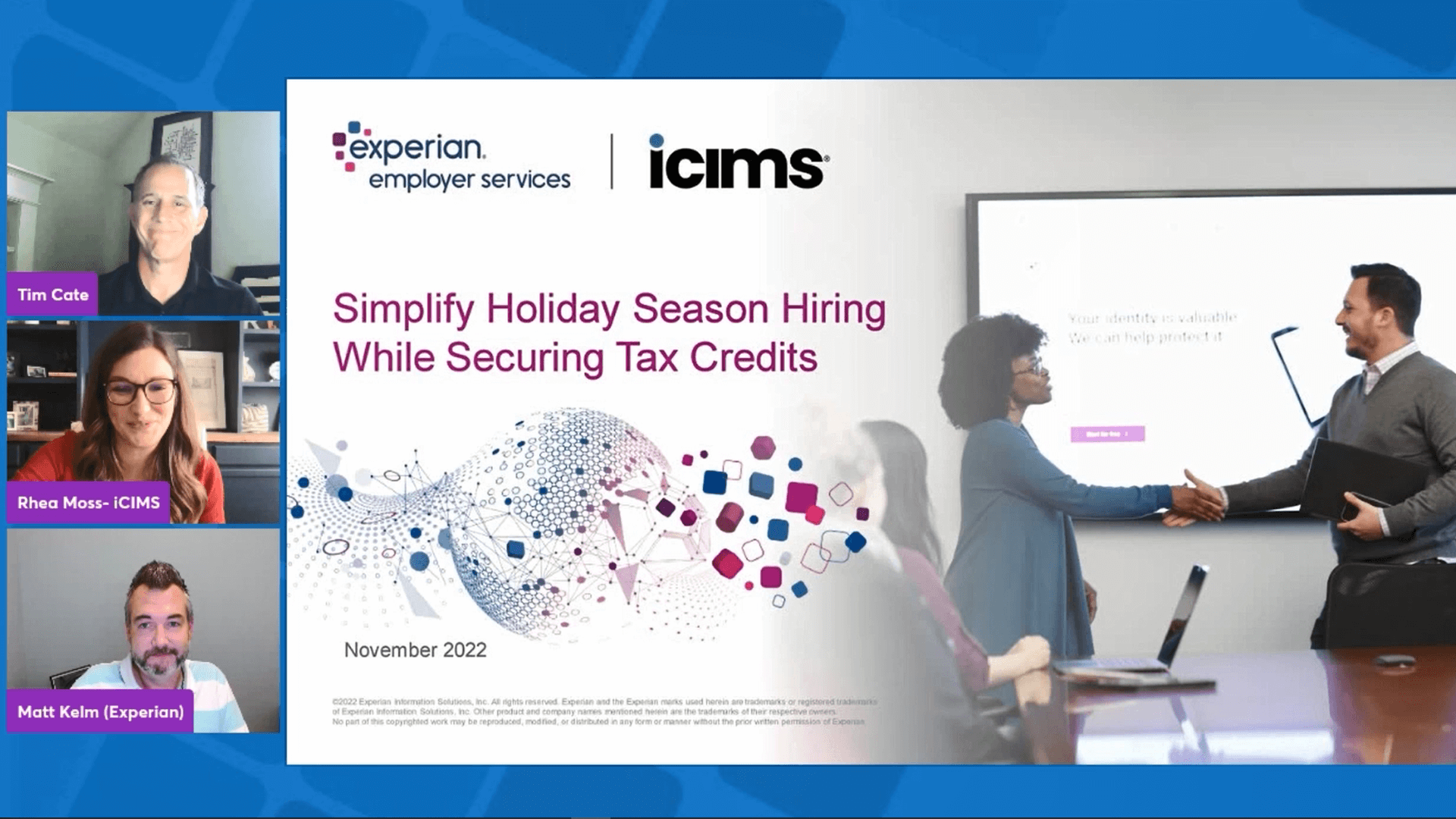Hiring peaks can inundate HR departments with additional administrative burdens, making it a struggle to keep up when there’s a surge of new applicants and employees. At certain times of the year applications in the retail sector can increase by 30%. The good news is there are processes employers can incorporate now to simplify hiring, improve onboarding, and capture tax credits to save money with each new hire. Learn from Tim Cate, Vice President of Strategy with Experian Employer Services and Rhea Moss, Director of Data Insights and Customer Intelligence with iCIMS, in this discussion moderated by Matt Kelm, Vice President of Sales with Experian Employer Services.
This excerpt is from a webinar with Experian Employer Services and iCIMS on how to improve onboarding to simplify hiring. Watch the full version.
Matt Kelm: When it comes to themes that you’re hearing around, you know, “ghosting”, or people call it “quiet quitting,” do you anticipate those are trends that will continue or will they continue perhaps only in certain sectors like retail?
Rhea Moss: I think there’s a lot of misaligned expectations between employers and candidates right now. When we think of ghosting, what immediately comes to my mind is asking if this is a candidate’s market or an employer’s market, and where they shift and when the candidates really feel like they have the upper hand. I will say they’re more likely to say they don’t like the way this process is going so they’re tapping out if there’s confidence in that. When we’d expect higher levels of unemployment or more of an almost desperate job seeker, it’s very different.
A job seeker who’s willfully and happily employed versus a job seeker who really needs to put food on the table, they’re going to behave in very different ways and I think that over the last year what we’ve seen is a lot of that power dynamic really shifted to the candidate where they said I feel confident enough to put my foot down. I would say similar thoughts on the quiet quitting piece is if you’re in a role and you think I’m allowed to set my own limits and my own expectations and I’m only going to do X right, that it’s similar both as an employee and as a candidate, where you say I’m going to put up with only so much and anything else ‘no thank you,’ that comes from a level of confidence in the labor market and I would say I think some of those trends are long-term trends probably, but I think we’re seeing that an overwhelming majority will start to shift as we see things like the unemployment levels go up.
Matt Kelm: That’s fantastic. Last question for you, Rhea, in September we saw the conference board leading economic indicator go negative for the first time in a while. I believe every time that indicator has gone negative since the 50’s we’ve hit a recession roughly seven months after that, so any predictions for when you see not just the recession but the labor market turning? And I think that’s an important thing to call out for the audience. If we’re seven months out of September traditionally when a recession hits, when can we start to actually see tangible softening and a transition from the candidate market to the employer market?
Rhea Moss: It’s a great question. My favorite answer to this question is usually my crystal ball is broken, I’m very sorry, but what I will say is we’re seeing so many things at play and where I bring that back is really in the last two to three years we saw factors of employment and of talent acquisition, so it’s not just unemployment and underemployment and inflation you’ve added things like emotion, a lot of emotion, you’ve added things like safety and we talked about this a lot in 2020 but I don’t know that we did. I feel like we’ve kind of let these conversation go to the wayside where we talk about candidates that don’t want to go back to work because they’re worried about getting sick, or candidates that are worried that like their child’s school closes and they’re home for a few weeks and while those things are not nearly as common as they were in the early days of the pandemic, there are still pieces of that. There’s a lot more human emotion that’s brought into the employment situation in ways that I think historically we didn’t think of. It was very factual, unemployment’s at X number of jobs openings at Y and you go find a job and you do your job and you get your paycheck. Now when we talk about things like ‘quiet quitting,’ there’s an emotional aspect to that that I don’t think we were really thinking of as a main factor a couple years ago. As far as my answer to you, I don’t know how are people going to react. It’s not just what the economy is going to do, what is inflation going to do? What will the interest rate be like? We can rattle off the academic thought process there but I think there’s a huge psychology piece. We haven’t been through a pandemic before to know how long this takes to wear off, but it is still a factor in play today.
Matt Kelm: Good stuff thank you very much, Rhea. We are going to transition over to Tim, he’s going to talk a little bit more about the impact of the Work Opportunity Tax Credit. Over to you Tim.
Tim Cate: Thanks Matt, thanks Rhea, that was really fascinating information, and again I’m going to try to tie a lot of that in because it does tie in to the Work Opportunity Tax Credit, and exactly kind of what we’re seeing in the market today as well a lot of which was more empirically visible, but it’s really backed up by some of the data points that Rhea provided so very helpful.
What we’re seeing in the current state of the retail workforce is that there is a tremendous amount of pressure to get employees through the hiring process quickly [and improve onboarding.] We constantly hear from our clients that say we want to get people through more quickly, but on balance with that is all of this wage and other inflationary pressures so companies are looking for ways to save money, to kind of squeeze out any bit of savings they can find through the system, but at the same time balance that with keeping the candidate experience as good as possible and keeping the time to apply as short as possible. WOTC has been around for a long long time and I’ll provide a little bit more background on that but it continues to be in place to encourage employers to hire individuals who experience a little bit more difficulty in finding a job, or maybe to offset some training costs for people who may be less experienced so it is designed to be an offset and sort of worked out.
A quick background on the Work Opportunity Tax Credit. you will hear it called WOTC and in the industry we often just say WOTC, so when you hear it they’re synonymous but it’s a tax credit, an incentive, that has been available to companies for hiring people with certain demographic backgrounds. You can think of people with the military, veterans who have been unemployed, people receiving food stamps or Medicaid and families that have received those benefits, really even folks who have been unemployed for a long period of time, those are all target groups. There are 11 of them, but generally that’s the type of criteria that qualifies for the program. It’s been in place since 1996 and has been modified and extended. It typically gets extended for a year or two at a time, sometimes longer than that as is the case right now. We’re in the midst of a five-year extension that takes us through 2025 which is very fortunate because that gives some certainty, but again we know that it’s been around since 1996 and we expect that it’s going to continue because it does have such strong bipartisan support and even ahead of 1996 there was a predecessor program that worked much the same. There were some pretty key differences, but this predecessor program called Targeted Jobs Tax Credits, or TJTC, was in place beginning in 1980. So this program or one like it has been in place for over 40 years and it’s definitely a tool that is used to incentivize hiring among these groups that are traditionally deemed to have higher rates of unemployment. It is jointly administered by the IRS which is a taxing authority and the Department of Labor which is really on the side trying to make sure there are these opportunities, and the design is to incentivize employers for hiring these individuals but there is a key caveat, and that caveat is that they are supposed to know they’re hiring somebody ahead of that job offer. So there is a statutory requirement that screening occur on or before the day a job offer is made. It can be on that day but typically doing it while onboarding is too late, so I’ll talk a little bit more about this statutory of compliance requirements and the dangers of trying to circumvent that as well.



